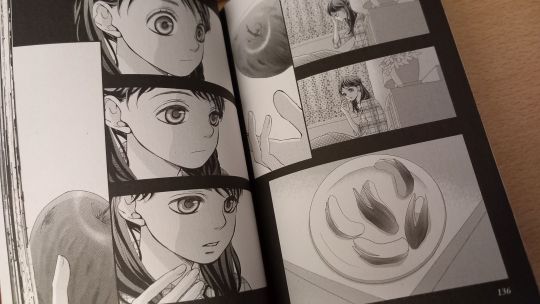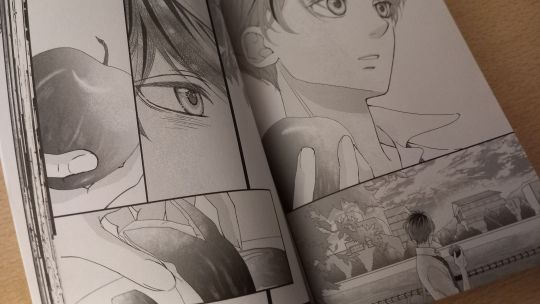#hatsu haru
Explore tagged Tumblr posts
Text

#hatsu haru#manga#shizuki fujisawa#romance manga#hatsu*haru#kai ichinose#riko takanashi#kai x riko#shojo manga
3 notes
·
View notes
Text
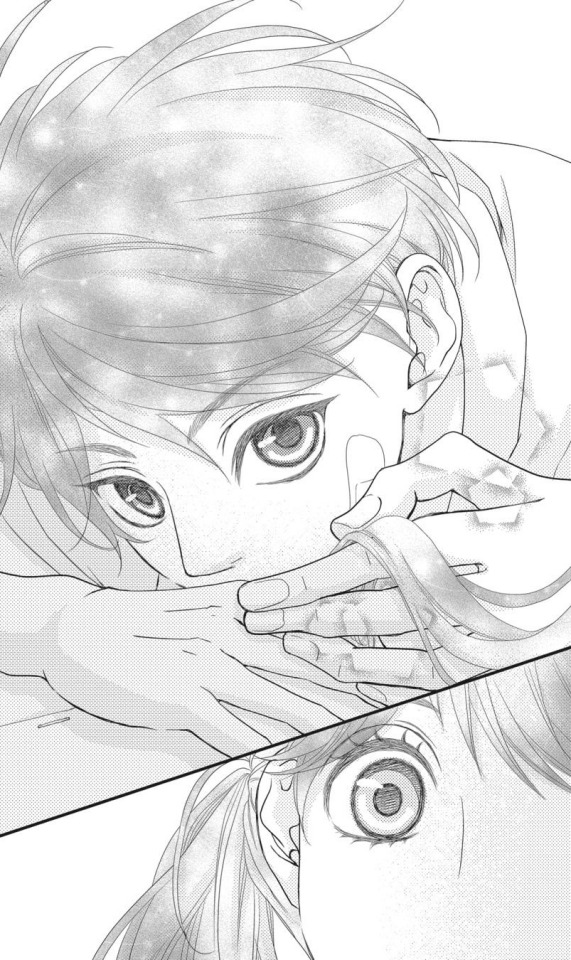
10 notes
·
View notes
Text
So cute! Probably one of the purest couples ever!

4 notes
·
View notes
Text

Waiting for Spring
Available digitally (can read on Kmanga)
Available in print
#hahahaha so#he is not the ML#or even an option#but id go feral over him#i love him most#hes a bit mischevious#manga#manga recommendation#screencaps#manga panel#romance#fyres hyperfixations#shoujo#shojo#kodansha#school setting#waiting for spring#haru hatsu bokura
6 notes
·
View notes
Text
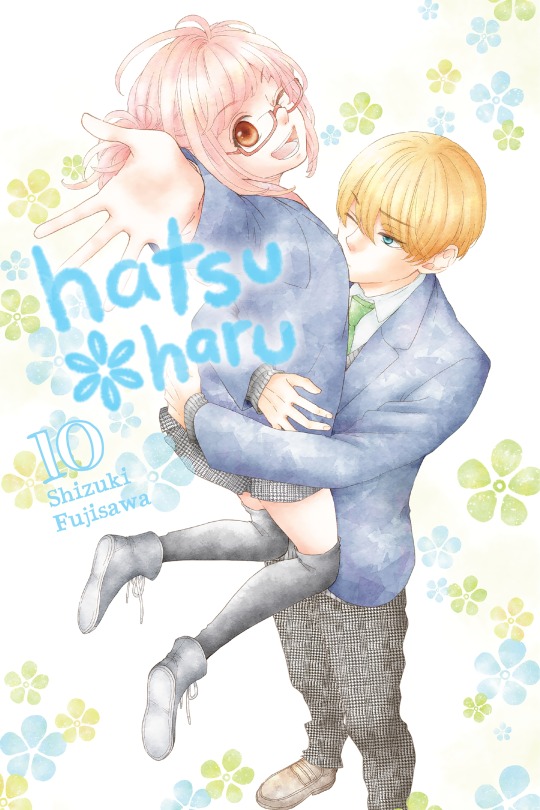
Hatsu*Haru
Story & Art by Shizuki Fujisawa
Manga Volume 10
Shoujo, Romance, Drama, High-School Setting
Story ★★★★★ || ★★★★☆ Art
Summary
Thanks to Riko’s heroic instinct, she took first prize in the Hottest Guy Contest and won a trip to a hot-spring resort. Kai has been eagerly awaiting their romantic getaway, but unfortunately for him, the dream trip for two has suddenly become a group affair. With Shimura and Misaki tagging along, alone time has dwindled to a thing of mere imagination. Odds take a turn in the boys’ favor, though, when Shimura insists on sleeping in Misaki’s room…The hope for intimacy may not be lost, after all!
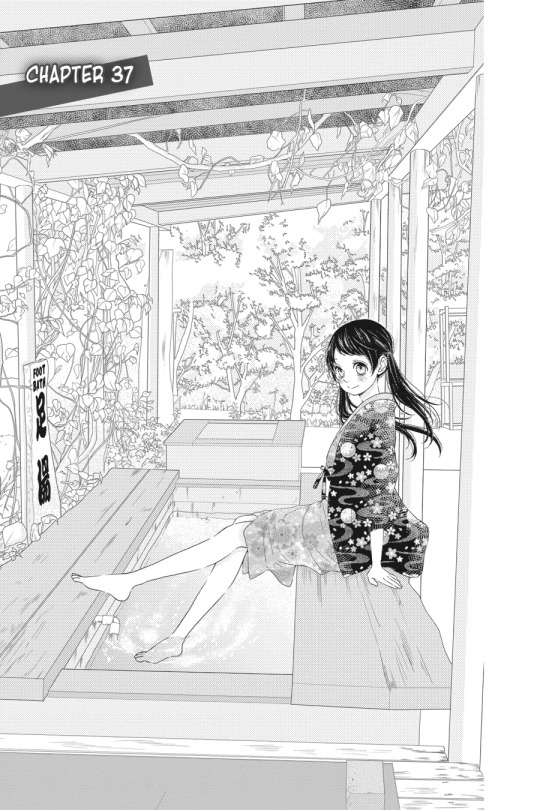


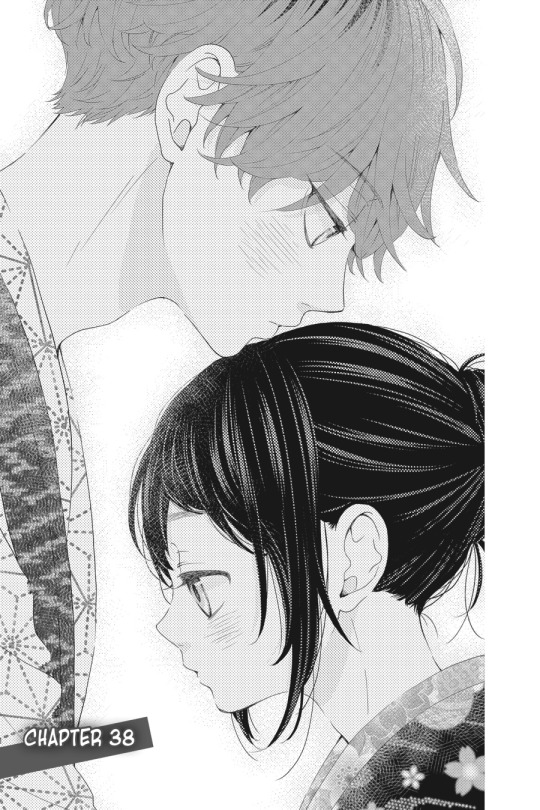
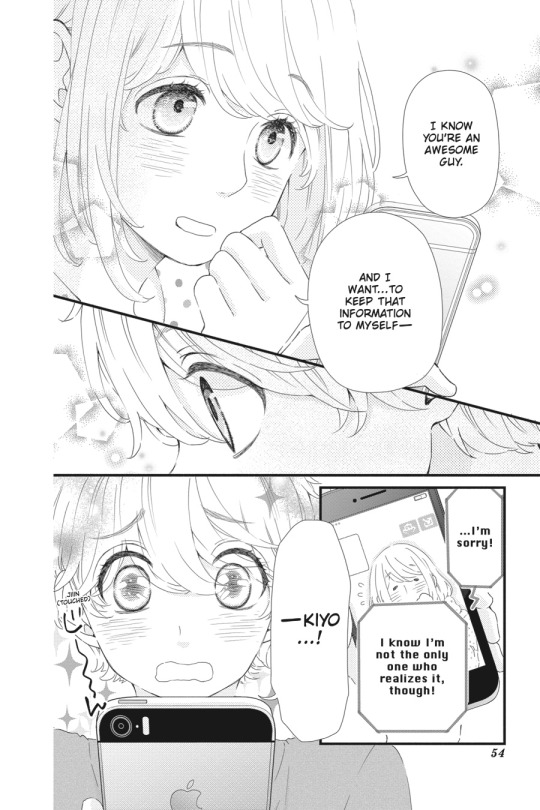

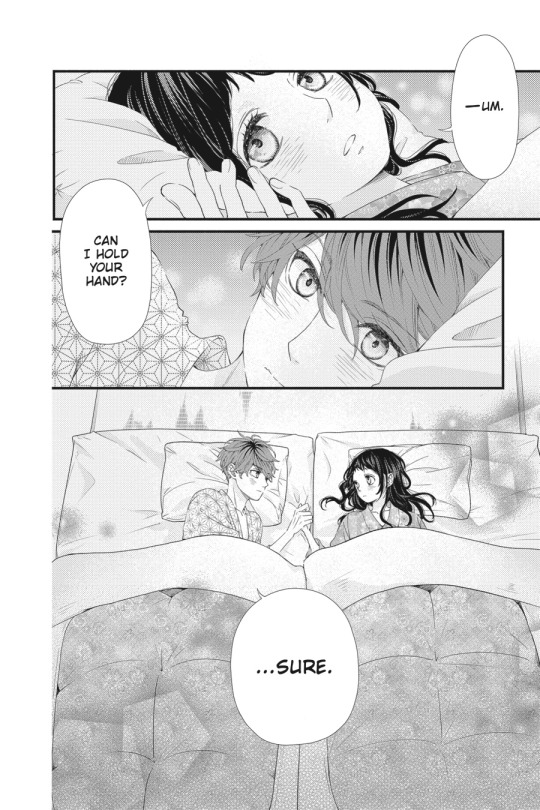
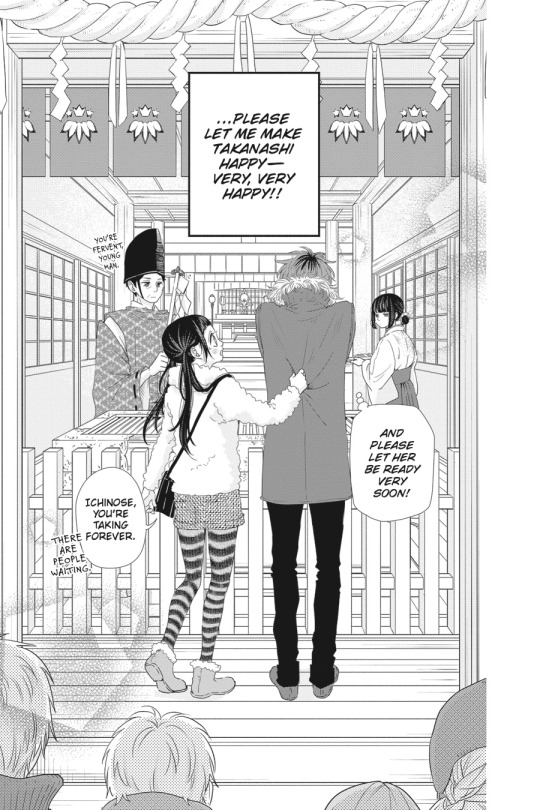
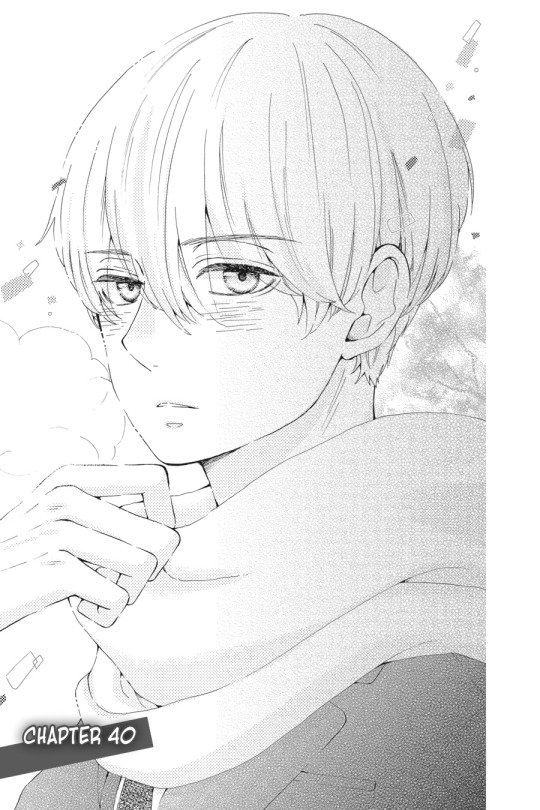

Review
This was a another cute volume. The first half is centered around Riko and Kai. They finally go on their over night spa trip, with Misaki and Shimura in tow, Riku just couldn’t go without a little buffer. In the end Riku and Kai grow closer and Kai is able to relive Riku of any misgivings she might have had. Kai teaches the guys to make Valentine’s Day chocolates. The last half centers around Misaki and Shimura and I think it was this conversation between them that solidified this as one of my favorites. How Shimura sees herself and her growing distance from her peers as they age is very relatable.

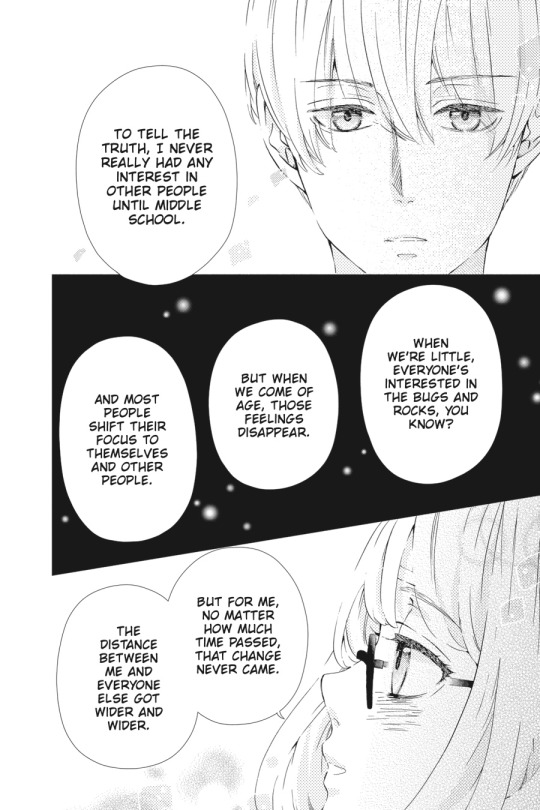
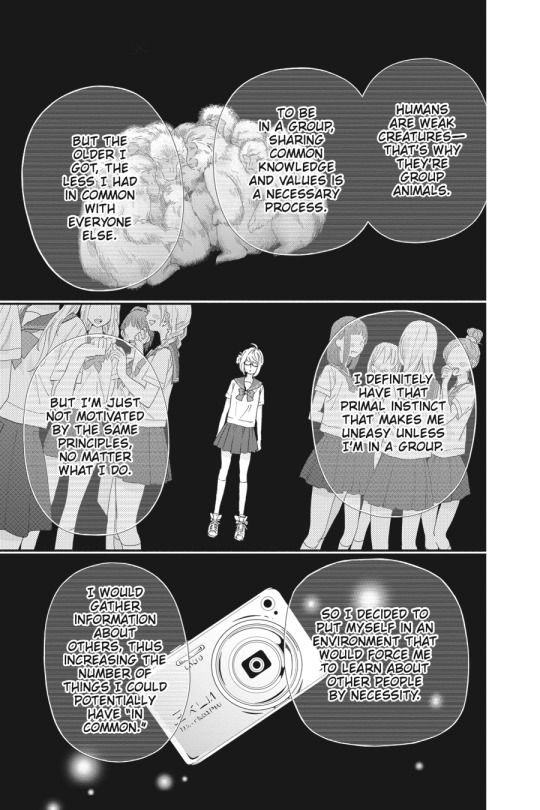

I really wanted to highlight the conversation Shimaru has about how she felt she lacked emotions, or at least how she felt she was different from all of her peers as they where growing up. She didn’t mature at the same rate, she didn’t and started to notice a distance grow between herself and all the other girls. This is so relatable to me as this is how I also felt at that age. It was like everyone was growing up and suddenly started caring about a lot of things that I didn’t know about, didn’t understand why it was suddenly important, and couldn’t relate too and even though I would try and ‘understand’ it I just didn’t get it, and over time my ‘faking it’ was noticed by others and distancing started to happen with some I was friends with in elementary school - I was now the weird one.
Unlike Shimaru, I did want to ‘fit it’ and tried hard too for a few years, before I realized that my faking it was giving people a misimpression of me - I later learned to call this ‘mirroring’ where people think I was like them or others I hung around with because I was just pretending to like what they did to fit in. I didn’t like that once I figured it out and had to resign myself to just be okay being me, even if it make it less likely I would fit it. So I just concentrated on making friends with those who could accept me as I was, even if they too considered me the ‘weird’ or ‘unique’ one in the group, it made my day to day less stressful. It was hard getting rejected over and over and always starting every year as if I was starting at a new school, worrying if I would have at least one friendly face in homeroom so there was someone to each lunch with.
Like Shimura, it wasn’t really my looks or dress that separated me, but my ‘being’ how I interacted with others and was lacking in heightened or typical emotions on what everyone else got excited over and many couldn’t deal with my oddness. I didn’t care about idols, or boy bands, or finding a boyfriend, or sports, or make-up, or fashion, or just socializing in general, etc… a lot of the typical ‘rights of passage’ that many people are just drawn to naturally and become passionate about.
It amuses me now that people denigrate the trope ‘not like other girls’ when that is how I used to describe myself, as I felt how hard it was to fit in with ‘normal’ girls/people… but I saw it as all negative, I wanted to be ‘normal,’ to be able to fit in and not feel like a fake, for it to be natural for me as it seemed to be for them, but I couldn’t. It wasn’t a choice or something that I could learn nor did I stand out as ‘cool’ or ‘better than’ or make me more popular with boys at all; but instead lonely and often the odd one out. Even painful when interacting with certain groups who didn’t like me and made it known. Luckily, most of the time I was just invisible or left alone, I would never consider the slight abuses and bullying (although painful at the time) to rise to the level of harassments or non-stop bullying I see others suffer though. I usually had at least a couple of kind people (oddly usually religious kids, though I wasn’t raised with religion) I could rely on, so I am grateful for that.
Anyway, I really loved this volume and this passage particularly. I was never as happy go lucky and confident as Shimaru, wish I could have been more oblivious and confident, but it is what it is. I feel like Ms. Fujisawa must have been like me to have understood this aspect of not fitting in so well, or at least was friends with someone who was. It is rare to see it written about, so that makes it stand out that much more to me.
2 notes
·
View notes
Text

📓 VOLUME 1 (1-4) ➙
1 note
·
View note
Text
「tubatu」 as fruits basket characters !。
summary: i love fb and txt :)
a/n: this is just my opinion thank u x

— YEONJUN!
… as kyo sohma!

— SOOBIN!
… as yuki sohma!

— BEOMGYU!
… as akito sohma!

— TAEHYUN!
… as hatsu-haru!

— HEUNING KAI!
… as momiji sohma!

#txt x reader#txt reactions#txt x you#yeonjun x reader#taehyun x reader#beomgyu x reader#choi yeonjun x you#kang taehyun x reader#choi soobin x reader#heuning kai x reader
81 notes
·
View notes
Text

Below the cut will be a list of some of my favorite Japanese names. I like to write a lot of original characters that are based in different animes, so I thought this would be useful to have. These will be placed under a read more, as this post got quite long. There are 70 feminine names, 75 masculine names, and 31 gender neutral names. Please like or reblog this post if you found it useful. Thank you. :)
Feminine Names.
Airi.
Aina.
Amane.
Ami. / Aimi.
Anzu.
Asuna.
Aya.
Chidori.
Chiharu.
Chou.
Danuja.
Doi.
Ema.
Emica. / Emika.
Emi.
Emiko.
Etsuko.
Gina.
Hatsue. / Hatsu.
Hana.
Hanae.
Hanakao
Haruka.
Himari.
Himwari.
Hina.
Honoka.
Kairi.
Kaori.
Kanna. / Kana.
Karin.
Katsumi.
Kyoko.
Machi.
Mai.
Manae.
Mari.
Matsuri.
Mayumi.
Megumi.
Mei.
Midori.
Mika.
Mina.
Mirai.
Misa.
Misaki.
Miyah.
Miho.
Naho.
Nako.
Nami.
Nanami.
Naomi.
Reina.
Rei.
Rena.
Rika.
Sakura.
Saori.
Sarina.
Sayuri.
Seika.
Seina.
Shizuka.
Tae.
Tora.
Yuka.
Yuna.
Yurina.
Masculine Names.
Akane.
Akihito.
Akito.
Anji.
Arata.
Benjiro.
Choei.
Daihachi.
Daiji.
Daijiro.
Daisuke.
Daishiro.
Eiji.
Enzo.
Etsuji.
Genji.
Gorou.
Hajime.
Haruto.
Hatsuo.
Hideji.
Hiro.
Hiroshi.
Hiroto.
Hisaki.
Hyuga.
Judai.
Jun.
Jun'ichi.
Junpei.
Kaito.
Kakashi.
Kanji.
Kazuki.
Keitaro.
Kenji.
Ken'ichi.
Kentaro.
Kenzo.
Kiyoshi.
Koji.
Kota.
Kyo.
Masao.
Michaiki.
Mitsuhide.
Mokuba.
Naoki.
Naoe.
Renji.
Riku.
Ryo. / Ryu. / Ryou. / Ryuu.
Ryota.
Ryuuji.
Sasuke.
Satoshi.
Satoru.
Seto.
Shinji.
Shino.
Shintaro.
Soma.
Tadashi.
Taichi.
Takahashi.
Takeshi.
Taro.
Tooru.
Yota.
Yudai.
Yugi.
Yuji.
Yuma.
Yusei.
Zenji.
Gender Neutral Names.
Akari.
Akira.
Akihito.
Asuka.
Ayame.
Chiyo.
Dai.
Daichi.
Haku.
Haruhi.
Haru.
Hikaru.
Hikari.
Hinata.
Ino.
Kaeda.
Kai.
Kaoru.
Kenta.
Kita.
Minato.
Mitsuki.
Nara.
Noa.
Reiji.
Ren. / Rin.
Sato.
Shin.
Shion.
Shun.
Shuya.
Sora.
Yui.
Yuki.
#masterlist#mine#my masterlist#japanese names#japanese names masterlist#japanese names list#feminine japanese names#masculine japanese names#gender neutral japanese names#feminine names#masculine names#gender neutral names
42 notes
·
View notes
Text

hatsu haru
#shoujo#anime#romance#shoujo manga#mangá#anime art#aesthetic#couple#school life#black and white#kiss me#cute#kawaii#manga couple#mangá shoujo
70 notes
·
View notes
Text
What's In a Name? Part 25
On The Seventh Day of Fun I present... an addition to the oldest series! You'd think I'd be running out of kanji by now, and I admit that it's getting harder to find ones that I haven't covered, but you're in luck as here's a few that have yet to see the spotlight! Maru - 丸 Prefix or Suffix: Both Old Meaning: Circle New (Standardized) Meaning: Circle Found In: All Five Kagai A very masculine kanji, its main meaning is that of a circle, but it's also used as a suffix in the naming of important objects, such as ships, swords, musical instruments, etc. For these examples we'll be keeping to the main meaning, but just keep in mind the second meaning when thinking about how a person can present with that name. Examples 八重丸 Yaemaru (Gion Kobu): "Multi-Layered Circle," pretty straightforward yet also quite poetic. 千恵丸 Chiemaru (Pontocho): "1,000 Blessed Circles," this one's really neat as Maru has another hidden meaning: that of money! So, this could also translate as "1,000 Blessed Coins"! 勝丸 Katsumaru (Kamishichiken): "Victorious Circle," This is an extremely masculine name that likens to that of a battleship! 丸代 Maruyo (Miyagawa Cho): "Circular Era," let's do the time warp again? 福丸 Fukumaru (Gion Higashi): "Lucky Circle," like with the example of Chiemaru, this one could also use the hidden meaning of money and mean "Lucky Coin"! Hatsu - 初 Prefix or Suffix: Both Old Meaning: First New (Standardized) Meaning: First Found In: Gion Kobu, Pontocho, and Gion Higashi Hatsu is the kanji of firsts for events and milestones. Since people in Japan are celebrating Hatsumōde 初詣, the first shrine visits of the year, today it's quite the appropriate kanji. Examples 初福 Hatsufuku (Gion Kobu): "Beginner's Luck," plainly this one could mean "First Luck," but it's easier to translate it as the above. 豆初 Mamehatsu (Pontocho): "New Bean," since it's being used as a suffix it's describing the bean in this case, but it could also mean "First Bean." 初子 Hatsuko (Gion Higashi): "First Child," pretty straightforward, could also mean "Firstborn." Ji/Haru - 治 Prefix or Suffix: Suffix Old Meaning: Reign, Peace, or Heal New (Standardized) Meaning: Reign, Peace, or Heal Found In: All Five Kagai This kanji's a bit on the archaic side and doesn't have a very clear meaning, but it's a gentle kanji that brings prosperity. Examples 長治 Chōji (Gion Kobu): "Long Reign," this one could also mean "Long Peace." 幸治 Yukiharu (Pontocho): "Peaceful Happiness," pretty straightforward but a very happy sounding name! 秀治 Hideji (Kamishichiken): "Excellent Ruler," this meaning seemed to fit the best with the paired kanji. 美代治 Miyoharu (Miyagawa Cho): "Era of a Beautiful Rule(r)," this one can be mixed around to make a few combinations, but this one came out sounding the best. 豊治 Toyoji (Gion Higashi): "Excellent Reign," the meaning is nearly identical to that of Hideji, but "豊" can also mean "Wealth," so another meaning for this name can be "Wealthy Reign/Ruler."
23 notes
·
View notes
Text
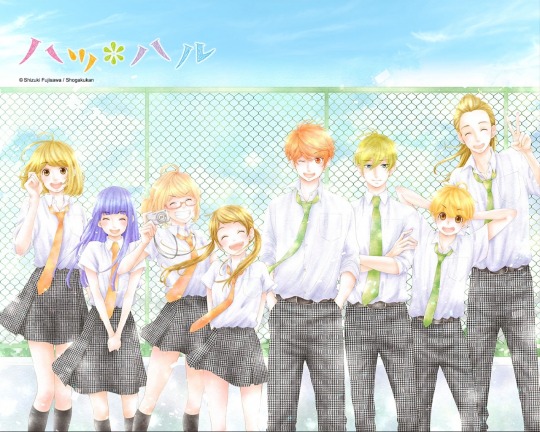
#hatsu haru#manga#romance manga#shizuki fujisawa#kai ichinose#takaya misaki#tarou toramaru#miki kiritani#riko takanashi#ayumi shimura#kagura tatsunami#kiyo ooshima
8 notes
·
View notes
Text
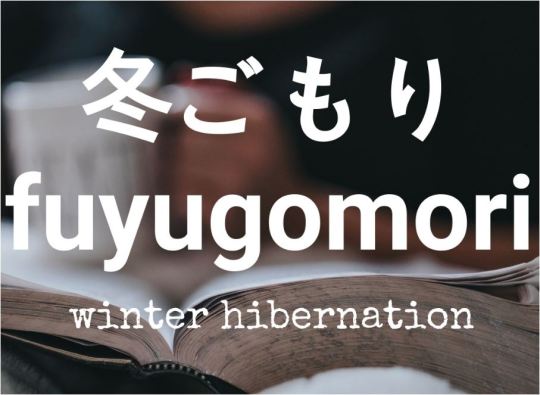
35+ Awesome Japanese Winter Words
Fuyu (冬)
Fuyu is the Japanese word for winter. It’s one of the four seasons in Japan. The other Japanese seasons are haru (spring), natsu (summer) and aki (autumn).
Samui (寒い)
Samui means cold in Japanese – and it is one of the most useful Japanese words for winter! If you’re in Japan during the winter months, you will hear almost every conversation start with samui desu ne – cold, isn’t it!
Yuki (雪)
Yuki is the Japanese word for snow. Snow is a symbol of winter in Japan, the same as many other northern hemisphere countries.
Japan is a large country with several different climates, so it doesn’t snow everywhere in Japan. The northern regions (especially Hokkaido) can be covered in snow for several months each year. But other parts of Japan (especially south of Tokyo) rarely see snow. Still, snow is a popular theme for winter cards, art and decorations.
Here are a few other snow related words in Japanese for you:
大雪 (oo yuki) – heavy snow
���雪 (hatsu yuki) – the first snow of the season
雪遊び(yuki asobi) – playing in the snow
雪合戦 (yuki gassen) – snow ball fight
雪祭り (yuki matsuri) – snow festival. The most famous snow festival is held in Sapporo, Hokkaido each February.
Kazahana (風花)
Kazahana is the Japanese word for snow flurry. If you are studying kanji, you might recognise the two characters that make up this word – 風 (kaza, wind) and 花 (hana, flowers). So a flurry of snowflakes is like little white flowers drifting in the wind. What a romantic image!
Ski (スキー)
Skiing is a popular winter hobby in Japan. The Japanese word スキー (ski) has been borrowed from other languages, so it’s easy to remember! It is written in katakana – the Japanese script used for foreign loan words.
Yukimi (雪見)
If you already know something about Japanese culture, you probably know that in Japan, people love to honour the changing seasons with different rituals that celebrate nature. Maybe you’ve heard of hanami – the spring time tradition of going to view the cherry blossoms. Well, yukimi means viewing the snow! Japanese people will often take the time to drink tea while admiring the snow.
Yukidaruma (雪だるま)
Yukidaruma means snowman in Japanese. Just like any other country, children love to build cute snowmen when it snows.The first part of the word, yuki, means snow. The second part, daruma, is a kind of round Japanese doll. Yukidaruma do look more like a ‘daruma’ than a ‘man’!
Bonus word: yukiusagi (雪うさぎ)
As well as snowmen, Japanese children love to make yukiusagi – snow bunnies! Usagi means rabbit in Japanese. Yuki usagi are smaller and easier to make than snowmen. Usually they are decorated with red berries for eyes and green leaves for ears.
Shirokuma (白くま)
Shirokuma means polar bear. Literally, it means white (shiro) bear (kuma). There aren’t any polar bears living in Japan, but a lot of people love them because they look cute, so they are kind of a symbol of winter and snow.
Kurisumasu (クリスマス)
Kurisumasu is Christmas in Japanese. It’s written in katakana, and of course it comes from the English word Christmas. Merry Christmas in Japanese is メリークリスマス (merii kurisumasu).
Christmas is not a big event in Japan because the country does not have a big Christian population. In fact, December 25th is a normal working day.
And it’s not considered a family day like in other countries. Christmas (or more especially, Christmas Eve) are actually thought of as romantic days in Japan! Christmas Eve is the hottest date night of the year – similar to Valentine’s day.
However, lately celebrating a western-style Christmas is becoming more and more popular in Japan.
Learn about some unique Japanese Christmas traditions here!
Oshougatsu (お正月)
Oshougatsu is New Year in Japanese. As we mentioned, New Year is much bigger than Christmas in Japan. In fact, many people consider it to be the most important holiday in the year. A new year represents a fresh start, and new hopes for the year ahead.
Most companies in Japan are closed from January 1 to January 3, and sometimes longer, to allow employees to spend time with their families.
The New Year period is typically a family time in Japan, with lots of traditions and special food.
Here are some other words associated with the New Year in Japan:
大晦日 (oomisoka) – Oomisoka means New Year’s Eve in Japanese.
年越しそば (toshikoshi soba) – Toshikoshi soba is one of many traditional dishes served at New Year in Japan. Soba are buckwheat noodles, and toshikoshi is another word for New Year. They are traditionally eaten on New Years Eve because the long shape symbolises long life.
おせち (osechi) – This is traditional food served on New Year’s day. All the ingredients of the meal have some special meaning for good luck over the next year.
初夢 (hatsuyume) – the first dream of the New Year
年玉 (otoshidama) – New Year’s gift, typically money given as a gift to children at New Year in red envelopes
年賀状 (nengajou) – New Year’s greetings cards
There are actually different greetings, depending on whether you say it before or after the new year!
Hatsumode (初詣)
Hatsumōde is an important New Year tradition in many Japanese families. It means the first visit to a shrine or temple in the New Year. Many people try to go on January 1st, but any time in the first three days is OK.
Due to this tradition, Shinto shrines in Japan are extremely busy in early January. Many of them have a kind of festival feel, with food stalls outside and lots of activity.
During hatsumode, people buy omikuji (pieces of paper with fortunes written on) and pray for their wishes for the next year.
Kotatsu (炬燵)
If you’ve ever spent a winter in Japan, the kotatsu will be your best friend! A kotatsu is a low table with a heater underneath. You can sit around it to keep your legs warm and toasty in the cold weather. They usually have a blanket attachment to keep the heat in, and for extra coziness.
Most Japanese homes don’t have central heating, so the kotatsu is an important way to stay warm in winter! Usually the family will all gather around the kotatsu and hang out on cold evenings.
Mikan (みかん)
Mikan are Japanese mandarin oranges. They are a common winter fruit in Japan. They are grown in the south of Japan, especially Ehime prefecture. It has lots of vitamins and keeps people healthy in winter.
Japanese people especially love to enjoy mikan while sitting around the kotatsu!
Here are some other winter foods in Japan:
ゆず (yuzu) – another Japanese citrus fruit with a kind of lime/lemon taste
かぼちゃ (kabocha) – Japanese pumpkin
おでん (oden) – kind of stew with boiled ingredients such as boiled eggs, fishpaste cakes, potatoes and daikon
鍋 (nabe) – a warming hotpot dish full of vegetables and meat or fish
焼き芋 (yakiimo) – roasted sweet potatoes which are often sold by street vendors or food trucks in winter
いちご (ichigo) – strawberries. Strawberries are considered summer fruits in many other countries, but in Japan they are most popular in winter.
もち (mochi) – rice cake sold and eaten especially at new year, and also used in new year decorations.
Fuyu gomori (冬ごもり)
Do you like to escape from the world and stay indoors all winter? If so, you’re taking part in fuyu gomori – winter confinement or hibernation! The kotatsu is the perfect place for fuyu gomori 🙂
Setsubun (節分)
Setsubun is considered the last day of winter and beginning of spring in Japan. It takes place on February 3rd.
On setsubun, many Japanese families take part in a tradition to scare away evil spirits before the new season starts. For this tradition, the father of the household dresses up in a demon mask and comes to the front door of the house. The other family members throw soy beans at him, shouting 鬼は外! 福は内! (Oni wa soto! Fuku wa uchi!), which means ‘Demon out! Luck in!’, to chase him away. This is supposed to bring happiness for the new year.
Some people also attend a shrine on this day, or eat a special sushi roll called ehō-maki facing a lucky direction.
13 notes
·
View notes
Text



Hatsu Haru✨
Otra de las muñequitas de vtubers que hice~
Tomó mucho tiempo y concentración hacer la flor de la espalda así que aprecienla(?
#amigurumi#crochet#bordado#amigurumi argentina#handmade#amigurumi doll#vtuber#vtuber fanmerch#fan merch#vtuber merch
2 notes
·
View notes
Text


2023

2022

2021
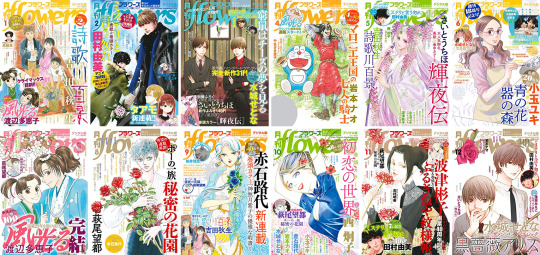
2020
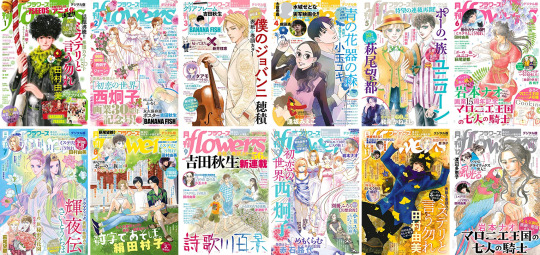
2019
Gekkan flowers[月刊flowers(フラワーズ)]: Monthly flowers

Kannazuki Yukariko no Yuuga na Himatsubushi[神無月紫子の優雅な暇潰し]
MARRONNIER Oukoku no Nana-nin no Kishi[マロニエ王国の七人の騎士]
Suuji de Asobo[数字であそぼ。]
Ookami no Musume[狼の娘]
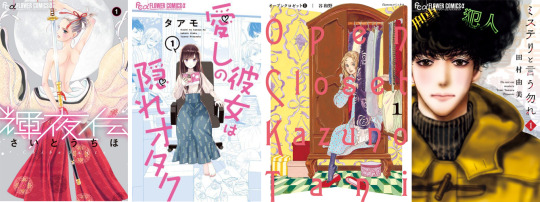
Kaguya-den[輝夜伝]
Itoshi no Kanojo wa kakure OTAKU[愛しの彼女は隠れオタク]
OPEN CLOSET[オープンクロゼット]
MYSTERY to Iu Nakare[ミステリと言う勿れ]

Hatsu Koi no Sekai[初恋の世界]
AraaraKashiko[あらあらかしこ]
Kurobara ALICE D.C.al fine[黒薔薇アリス D.C.al fine]
Utagawa Hyakkei[詩歌川百景]

POE no Ichizoku[ポーの一族]
...Ao no Pandora[... 青のパンドラ]
...Himitsu no Hanazono[...秘密の花園]
...UNICORN[...ユニコーン]
...Haru no Yume[...春の夢]

Nekoyama-san[猫山さん]
GURE-sanpo[グレさんぽ]
Fushigi Yuugi: Byakko Senki[ふしぎ遊戯 白虎仙記]
Boku no GIOVANNI[僕のジョバンニ]

Ao-no-Hana, Utsuwa-no-Mori[青の花 器の森]
Furuginuya Monyouchou[ふるぎぬや紋様帳]
Futari Bocchi[ふたりぼっち]
Kaze Hikaru[風光る]
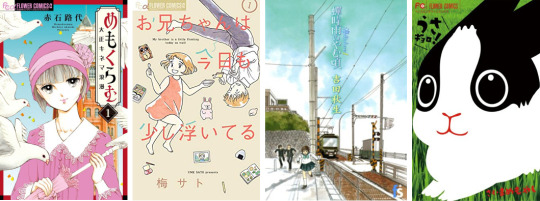
Memokuramu - Taisho CINEMA Roman(ce)[めもくらむ 大正キネマ浪漫]
Onii-chan wa Kyou mo Sukoshi Uiteru[お兄ちゃんは今日も少し浮いてる]
Umimachi Diary[海街Diary]
UsaGYORO[うさギョロ!]
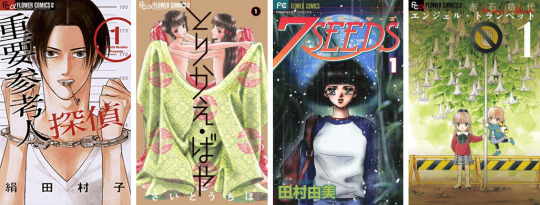
Juuyousankounin Tantei[重要参考人探偵]
Torikae Baya[とりかえ・ばや]
7SEEDS[セブン シーズ]
ANGEL TRUMPET[エンジェル・トランペット]

Tsukikage BABY[月���ベイベ]
Kin no Kuni Mizu no Kuni[金の国 水の国]
Jigoku no Sata mo Kare Shidai[地獄の沙汰も彼次第]
Yume no Mahiru[夢の真昼]
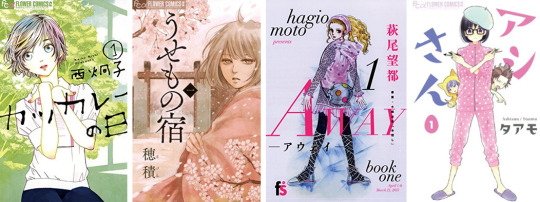
KATSU CURRY no Hi[カツカレーの日]
Usemono Yado[うせもの宿]
Away [アウェイ]
ASHI-san[アシさん]
#manga covers#magazine covers#picking a josei magazine for a change of pace was such a good idea#how refreshing to have a selection of manga that i dont have to cringe and roll my eyes at every 3rd title
28 notes
·
View notes
Text
Bokura no Kagayaki - Umeda Erika, Okai Chisato, Arihara Kanna
ºC-ute Concert Tour 2007 Haru ~Golden Hatsu Date~
4 notes
·
View notes
